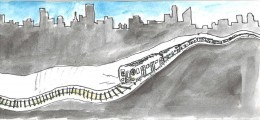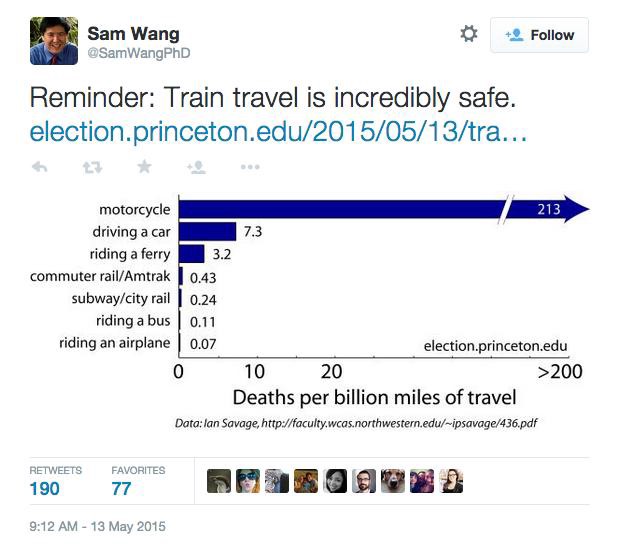Riding The Rails: The Sad State of America’s Trains

As you’ve probably heard, an Amtrak train derailed near Philadelphia, killing at least six people, injuring dozens more, and terrifying us all.
Philadelphia Mayor Michael Nutter told reporters early Wednesday that not all of the passengers on the train’s manifest had been accounted for.
“It is an absolute, disastrous mess,” Nutter said. “Never seen anything like this in my life.”
The mayor added that there were train cars that were “completely overturned, on their side, ripped apart.”
“It is a devastating scene down there,” he said. “We walked the entire length of the train area, and the engine completely separated from the rest of the train, and one of the cars is perpendicular to the rest of the cars. It’s unbelievable.”
Amtrak released a statement early Wednesday saying it was “deeply saddened by the loss of life.” The company earlier announced that service between New York and Philadelphia had been suspended indefinitely.
As tragic as it was, this wasn’t even the week’s only Amtrak crash:
Another Amtrak train crashed on Sunday. That train, bound for New Orleans, struck a flatbed truck at a railway crossing in Amite, La., killing the truck’s driver and injuring two people on the train.
In March, at least 55 people were injured when an Amtrak train collided with a tractor-trailer that was stuck on the tracks in North Carolina.
In all, 67 accidents involving Amtrak trains were reported in 2014, up from 58 the year before but down from a high of 150 in 2001.
I’ve spent lots of time on Amtrak in my life; starting as a young teenager, my mom even let me ride by myself from DC to NY. I knew I was supposed to get off at Pennsylvania Station in Manhattan, which was, in and of itself, confusing — shouldn’t Pennsylvania Station be in Pennsylvania? I had never paid enough attention to know beforehand that there are lots of Penn Stations. By the time I finally disembarked at the correct Penn station in the correct city, anxiety had turned me the color and consistency of whitefish.
Still, I made it, and I felt quite proud of myself.
I’ve continued to take Amtrak from Virginia to Vermont, familiarizing myself with the veggie- and budget-friendly options in the cafe car (veggie burgers; yogurt), writing novels, shamelessly eavesdropping on conversations, exchanging life stories with strangers whose names I never learn, parading my daughter endlessly up and down the aisles. For the most part I haven’t even thought to be afraid. Trains feel safer than busses or planes: they’re bigger, more powerful, and more expensive than the former, and unlike the latter they run reassuringly along the ground.
That sense of greater security on trains is indeed born out by the data.

All the same, our country has underinvested in infrastructure, and in our rail system, for decades. And there are consequences.
Amtrak has been starved of the funds required to keep up with this increased demand. The Northeast Corridor is shouldering a backlog of repairs expected to require $4.3 billion in fiscal year 2019, while federal funding is expected to dwindle to $872 million. … even if they keep Amtrak funding levels where they are, Congress is guaranteeing more dysfunction and more breakdowns in the system as maintenance costs rise. Those breakdowns can range from creating minor inconveniences, like being 20 minutes late to work, to potential catastrophes, like Tuesday’s derailment.
Glide along the tracks in Europe and Asia and you’ll wonder, as others have done before you, Why can’t America have great trains?
It’s easy to love trains — the model kind, the European kind, the kind whose locomotives billow with steam in black-and-white photos of the old American West. It’s harder to love Amtrak, the kind we actually ride. Along with PBS and the United States Postal Service, Amtrak is perpetual fodder for libertarian think-tankers and Republican office-seekers on the prowl for government profligacy. Ronald Reagan and George W. Bush repeatedly tried to eliminate its subsidy, while Mitt Romney promised to do the same. Democrats, for their part, aren’t interested in slaying Amtrak, but mostly you get the sense they just feel bad for it. “If you ever go to Japan,” former Amtrak board member and rail die-hard Mike Dukakis told me, “ride the trains and weep.”
It’s true: Compared with the high-speed trains of Western Europe and East Asia, American passenger rail is notoriously creaky, tardy, and slow. The Acela, currently the only “high-speed” train in America, runs at an average pace of 68 miles per hour between Washington and Boston; a high-speed train from Madrid to Barcelona averages 154 miles per hour. Amtrak’s most punctual trains arrive on schedule 75 percent of the time; judged by Amtrak’s lax standards, Japan’s bullet trains are late basically 0 percent of the time. …
And yet, despite this outpouring of popular demand, despite the clear environmental benefits of rail travel, despite the fact that trains can help relieve urban congestion, despite the professed enthusiasm of the Obama administration (and especially rail fan-in-chief, Joe Biden) for high-speed trains — despite all of this, Amtrak, which runs a deficit and therefore depends on money from Washington, remains on a seemingly permanent path to mediocrity.
Public transportation in America’s cities is hardly better, if it exists at all. Is it any wonder that fed up corporations have started investing in their own rails?
[New Balance] is breaking ground on the new Boston Landing station, starting a process that will add another stop on the commuter rail line between Boston and Worcester by the fall of 2016. New Balance is paying to build the station, which will cost between $14 million and $16 million, and will then pay for its maintenance costs for at least the first decade after the station opens.
The cost of the station is a relatively small piece of the $500 million, 15-acre real estate development planned by NB Development Corporation, a real estate company owned by New Balance. But the partnership between the company and the state, whose transportation officials supervised and approved the design of the station, is significant.
There has to be a better solution than waiting for private companies to reach into their own pockets. Or, as Mayor Bill deBlasio (NYC) and Mayor Mick Cornett (Oklahoma City) put it in a Times op-ed today, the status quo will continue, wherein “working Americans pay the price of federal apathy.”
Support The Billfold
The Billfold continues to exist thanks to support from our readers. Help us continue to do our work by making a monthly pledge on Patreon or a one-time-only contribution through PayPal.
Comments